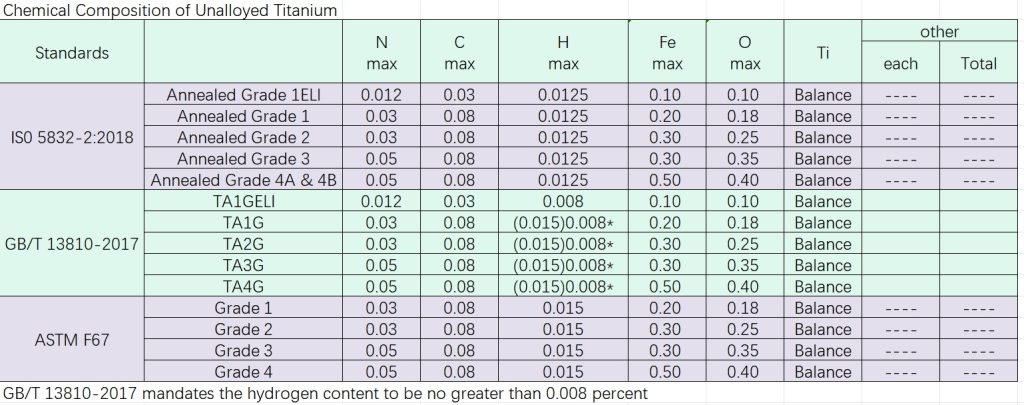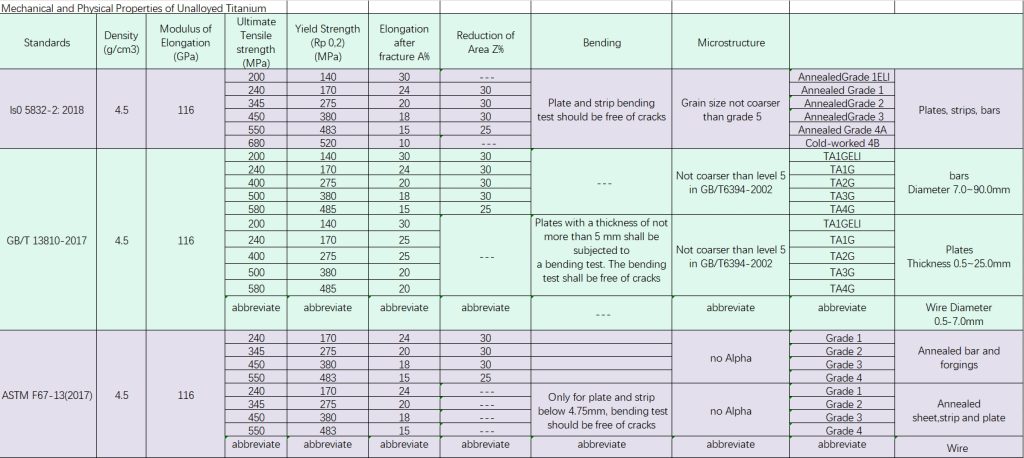The abundance of titanium in the earth’s crust is 0.63%, ranking 10th after oxygen, silicon, aluminium, iron, calcium, sodium, potassium, magnesium and hydrogen, and is 17 times greater than the sum of the common metals zinc, lead, nickel and copper. Most of the titanium is in a dispersed state, and the main minerals are rutile (TiO2) and ilmenite (FeTiO3) comprising a complex vanadium ilmenite.
Titanium has an atomic number of 22 and a melting point of 1,668±4°C. It is used in the manufacture of titanium.
Pure titanium has a density of 4.3, which is just over half that of stainless steel or cobalt chromium molybdenum. The modulus of elasticity of pure titanium is about 100 GPa, half that of stainless steel or cobalt chromium molybdenum and about five times that of cortical bone.
Pure titanium has a hexagonalclose packed atomic arrangement.
Pure titanium has a low average strength, good plasticity, and a yield strength between 140 and 520 MPa. It is not suitable to be used for parts with large load-bearing capacity, such as joint handles. It can only be used for small load-bearing parts such as socket cups, straps, and socket pins.
Pure titanium is easy to process and form, stamping, welding, cutting processing performance is good. It has good corrosion resistance in the atmosphere, seawater, wet chlorine gas and oxidising, neutral and weakly reducing media, and its oxidation resistance is better than most austenitic stainless steels.
Dense surface smooth titanium has good stability to nitric acid, which is due to the nitric acid can quickly generate a solid oxide film on the surface of titanium, but the surface roughness, especially titanium sponge or powdered titanium, can be reacted with secondary, hot dilute nitric acid, and higher than 70℃ concentrated nitric acid can also be reacted with titanium.
High-purity titanium has an elongation of up to 50-60 per cent and a section shrinkage of up to 70-80 per cent. Industrially pure titanium contains high amounts of interstitial impurities (oxygen, nitrogen, carbon), which greatly increase the strength of titanium and significantly reduce the plasticity.
The corresponding standards for pure titanium for surgical implants are the international standard ISO 5832-2, the Chinese national standard GB/T 13810, and the American ASTM F67, see Table 1. In the appendices of the standards for artificial hips and knees, YY 0118 and YY 0502, it is stated that only the international standard and the national standard are recognised as the standards for implant materials, and that the American ASTM standard is only to be used as a reference. From an international perspective, all three standards are permissible standards for pure titanium implants. Table 2 lists the chemical composition of pure titanium in the three standards. Table 3 lists the physical and mechanical properties of pure titanium in the three standards. The density and modulus of elasticity are from other sources than the above standards.
The international standard ISO 5832-2 is divided into Grade1ELI, Grade1, Grade2, Grade3 and Grade4 according to their different impurity contents. their interstitial impurity elements are gradually increased, and the strength is also increased, while the plasticity and elongation are decreased. ELI is the abbreviation of extra low interstitial, which stands for extra low interstitial impurity content.
The main differences between the international standard ISO 5832-2, the national standard GB/T 13810 and ASTM F67 are: 1) The content of elemental hydrogen is different. 0.0125% for ISO 5832-2, 0.008% for GB/T 13810 and 0.015% for ASTM F67. 2) ISO 5832-2 and GB/T 13810 include ELI grade, while ASTM F67 does not include ELI grade.
On the surface of pure titanium and titanium alloys, titanium and oxygen form an oxide film (Ti+ O2 = TiO2) on the articulating surfaces that can only be retained under low stress and slow friction. Once this oxide film is worn off, pure titanium or titanium alloy surfaces wear faster. Therefore, pure titanium and titanium alloys are not wear-resistant and cannot be used as articulating surface components, such as ball heads, single-stage heads, bipolar head cups and femoral condyles of knee joints, etc. The appendices of ISO 21534 and YY 0118 as well as YY 0502 explicitly state that titanium and titanium alloys are not allowed to be used for articulating surface components.
Table 1 Pure titanium standards

Table 2 Chemical composition of pure titanium

Table 3 Mechanical and physical properties of pure titanium




